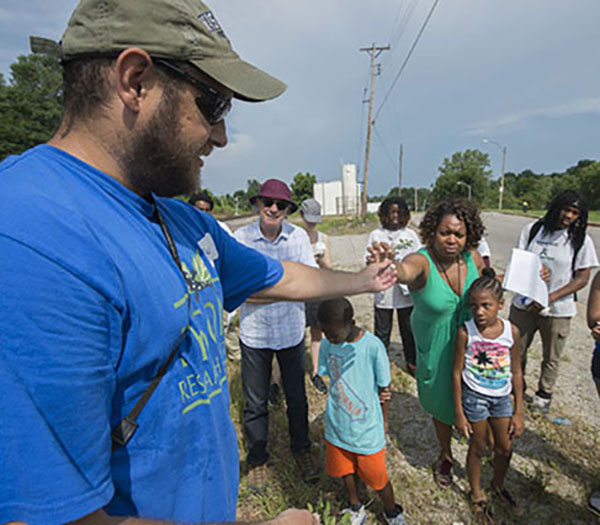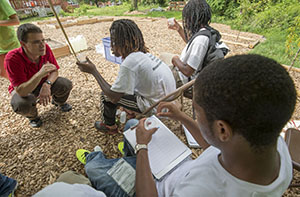
Plywood covers the windows. Painted blue dots mark the doors. The bungalows of Bittner Avenue in the north St. Louis neighborhood of Baden will be torn down this summer, victims of chronic flooding.
The demolition is another loss for Baden, a once-vibrant neighborhood with a shrinking tax base. Yet this close-knit community is determined to turn things around with the assistance of a team of Washington University in St. Louis researchers.
New homes are out of the question; the Metropolitan Sewer District has deemed this corner of the Baden neighborhood unfit for development. But gardens, nature trails and parks all are possibilities, said Kim Medley, PhD, interim director of Tyson Research Center.
“We know from conversations with the residents that they want beauty and something functional,” Medley said. “The question is how do we come together in an interdisciplinary way to create something unique?
“Ultimately, the goal is to connect people to nature in a way that will benefit the community and environment at the same time,” Medley said.
Earlier this month, university researchers visited the neighborhood to discuss the project with children and seniors who live there. They demonstrated how they will inventory plants and test soil quality and structure.
One child asked if wild strawberries are safe to eat.

“Absolutely,” said Tyson ecologist Travis Mohrman as he popped one in his mouth.
Another resident asked about goldenrod growing along the railroad tracks.
“Goldenrod gets a bad rap,” he said. “You can blame ragweed for your hay fever.”
Mohrman told the group a lot can be learned about a site by listening to the plant community.
“What herbivores are there, how much clay is in the soil, all sorts of things,” Mohrman said. “We think of nature as something that exists in the woods, but even in an urban setting, the ecosystem is multifaceted and complex with animals, insects and plants.”
The visit was the first of many that will bring together a diverse array of Washington University faculty and community partners. In addition to Medley and Mohrman, university experts include:
- David Fike, PhD, associate professor of earth and planetary sciences in Arts & Sciences;
- Rod Barnett, professor and chair of landscape architecture at the Sam Fox School of Design & Visual Art;
- Scott Krummenacher, PhD, postdoctoral teaching fellow in political science in Arts & Sciences;
- Bill Lowry, professor of political science in Arts & Sciences;
- Dan Giammar, PhD, the Walter E. Browne Professor in Environmental Engineering in the School of Engineering & Applied Science;
- Brent Williams, PhD, the Raymond R. Tucker Distinguished I-CARES Career Development Assistant Professor in the School of Engineering & Applied Science; and
- Amy Eyler, PhD, assistant dean for public health and assistant professor in the Brown School.
Collaborating organizations are the Riverview West Florissant Development Corp., the Missouri Botanical Garden, the Missouri Department of Conservation and the City of St. Louis.
“This truly is a collaborative effort, both inside and outside of the university,” Medley said. “Never before have our scientists and architects worked so closely to understand the environment and propose a design solution, then study the effects.
“I’m really excited because we know that a healthy, functional and aesthetically pleasing environment provides numerous services to people, including health benefits,” Medley said. “Not only are you improving the air quality when you restore ecosystem function in urban areas, you are providing a place where people can take a walk and interact with their neighbors.”
Alderwoman Dionne Flowers, who represents Baden on the St. Louis Board of Aldermen, is thrilled that Washington University has made a commitment to the neighborhood. She brought her son Kyden, 3, to see the raised vegetable beds planted by local youth working for the Riverview West Florissant Development Corp., and led by the Missouri Botanical Garden.
“I would love for children in the neighborhood to be able to see and touch plants, and know where their food comes from,” Flowers said. “This is the stuff I did when I was a kid. It was an opportunity for me to learn.
“But it also looks good,” she said. “Creating paths and gardens will change the look of the neighborhood and improve housing values. People will say, ‘Yes, I am in the city, but I am in a very beautiful, botanical part of the city.’”